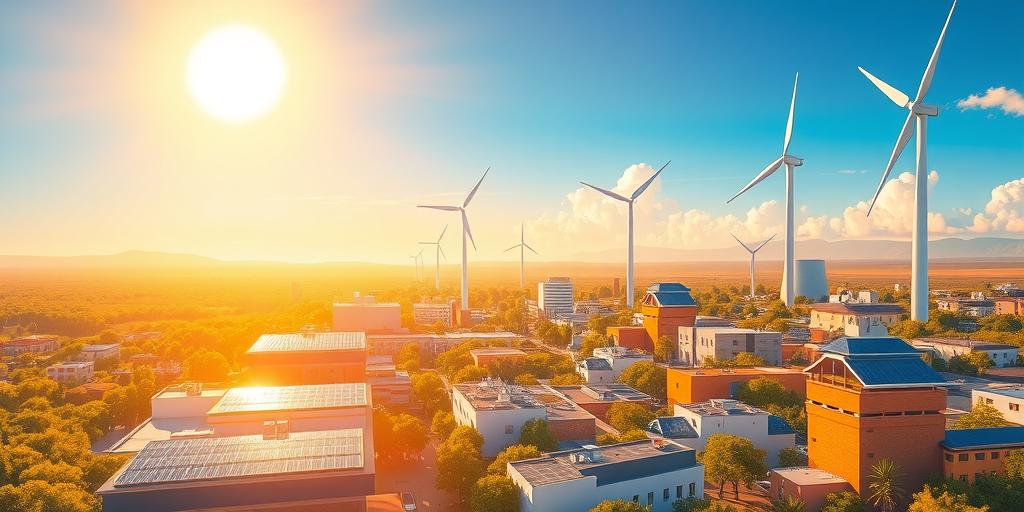Are you ready to witness the dawn of a sustainable future? The world is changing, and renewable energy innovations are at the forefront of this revolution, offering a brighter, cleaner tomorrow. From harnessing the power of the sun to tapping into the earth’s geothermal energy, the potential is vast, and the impact undeniable. Let’s explore how these advancements are paving the way for a greener planet and a more sustainable way of life.
Harnessing Solar Power: The Sun’s Untapped Potential
Sunlight, the most abundant energy source on Earth, is being harnessed like never before. Solar panels are becoming increasingly efficient, affordable, and aesthetically pleasing, seamlessly integrating into homes and businesses. But the innovation extends far beyond rooftop panels. Concentrated solar power (CSP) plants use mirrors to focus sunlight onto a receiver, generating electricity on a massive scale. These plants are transforming deserts into powerhouses, proving that even the most arid landscapes can contribute to a sustainable future. Imagine entire cities powered by the sun, reducing our reliance on fossil fuels and dramatically lowering carbon emissions. This shift is not just about reducing our environmental impact; it’s about energy independence and economic growth. The solar energy sector is booming, creating thousands of jobs in manufacturing, installation, and maintenance, contributing to vibrant local economies.
Advances in Solar Technology
Recent breakthroughs in perovskite solar cells have shown immense promise, potentially surpassing the efficiency of traditional silicon-based panels. Furthermore, advancements in energy storage technology, such as improved battery systems, are crucial for overcoming the intermittency of solar power, ensuring a consistent energy supply regardless of weather conditions. The development of floating solar farms, or “floatovoltaics,” is another exciting innovation, optimizing land use and minimizing environmental impact. These technological leaps are propelling solar energy towards becoming a dominant force in the global energy mix.
Wind Energy: Riding the Currents of Change
Wind energy, another cornerstone of renewable energy, has seen remarkable progress in recent years. Offshore wind farms, located further from land, can harness stronger and more consistent winds, significantly increasing energy generation. These colossal structures, sometimes stretching for miles, are becoming increasingly sophisticated. Advances in turbine design, including taller towers and longer blades, further enhance efficiency. The impact extends beyond clean energy production; offshore wind farms are creating new economic opportunities along coastlines, stimulating investment and employment. This isn’t just about generating electricity; it’s about creating resilient and sustainable coastal communities.
The Future of Wind Energy
The future of wind power is bright. Research into advanced materials, such as carbon fiber, is leading to lighter, stronger, and more efficient wind turbines. Floating offshore wind farms, similar to floatovoltaics, are opening up new possibilities in deeper waters, unlocking a vast untapped resource. Innovative designs, such as vertical-axis wind turbines, are also being explored, offering advantages in urban environments and potentially even revolutionizing small-scale power generation. The expansion of wind energy will continue to provide clean, abundant energy, ensuring future generations inherit a sustainable world.
Geothermal Energy: Tapping into the Earth’s Heat
Geothermal energy, harnessing the Earth’s internal heat, is a reliable and consistent source of renewable energy. Geothermal power plants use steam and hot water from underground reservoirs to generate electricity, offering a baseload power source that’s unaffected by weather patterns. This technology is especially effective in geologically active regions, providing a clean and sustainable energy solution. The benefits extend beyond electricity generation; geothermal heat pumps utilize the Earth’s temperature for heating and cooling buildings, significantly reducing energy consumption and carbon emissions. The environmental advantages of geothermal energy make it a vital component of a sustainable future. It’s a reliable power source with minimal environmental impact; a win-win situation.
Expanding Geothermal Applications
The applications of geothermal energy are continuously expanding. Enhanced geothermal systems (EGS) are being developed to tap into hotter, deeper resources, significantly increasing the potential of geothermal power generation. Furthermore, geothermal heat pumps are becoming increasingly popular for residential and commercial buildings, reducing reliance on fossil fuels for heating and cooling. This technology is transforming homes into eco-friendly havens. This growth in geothermal technology offers immense possibilities and strengthens our ability to create a sustainable world.
The Path to a Sustainable Energy Future
The transition to a sustainable energy future requires a concerted global effort, but the advancements in renewable energy technologies are undeniably paving the way. By combining solar, wind, and geothermal energy sources, along with advancements in energy storage and smart grids, we can create a resilient and sustainable energy system. This means not just minimizing our environmental impact but also boosting global economies, creating jobs, and securing energy independence for nations. The future is green, and it’s powered by innovation.
Embrace the change and join the renewable energy revolution! Learn more about how you can reduce your carbon footprint and contribute to a sustainable future. Let’s make a difference, together.




